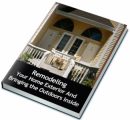
 License Type: Resell Rights
License Type: Resell Rights  File Size: 23,567 KB
File Size: 23,567 KB File Type: ZIP
File Type: ZIP
 SKU: 2429
SKU: 2429  Shipping: Online Download
Shipping: Online Download
Sample Content Preview
INTRODUCTION
Courtney Cox loves to buy homes, refurbish and redecorate them and then re-sell. Countless other celebrities do the same thing. In fact, celebrities spend thousands of dollars just to have professional decorators come into their homes and re-decorate them.
Still other famous people choose to get dirty themselves so they can realize their dreams of a home that is decorated the way they envisioned it to be. In fact, the television show “Trading Spaces” has actually taken interior decorating to a whole other level. People have visions of how they want their lives to be and how they want their living space to be. Celebrities and regular Joes alike possess these thoughts and dreams and want to see them come to reality.
What’s the difference? Obviously, it’s because most celebrities have an unlimited budget when it comes to their interior decorating views. We “regular people” generally don’t have that same luxury. If ‘Trading Spaces’ and segments about celebrity-inspired home decorating appeal to your creative senses, take a stand and create the home of your dreams! Interior decorating has taken new heights with the cost-effective styles and today’s trends available at most local chains and department stores.
Luxury living is a combination of eclectic, traditional, and unique styles with a contemporary but inspirational look. Even antiques can be transformed into vital accessories for today’s modern home, and add an air of distinction and originality to any corner.
Who needs a Hollywood designer when you can create great spaces on your own? Construct and build some versatile and chic domains on a variety of budgets and themes. Whether it’s the bedroom, living room, or elegant dining area that needs some updating, think like a celebrity to create some dynamic and unique living spaces!
Now, I should take a moment to let you know that interior decorating is definitely a matter of personal preference and style. What appeals to one person may be disgusting to another. But there are many, many decorating styles out there, and what we’re going to do in this book is present a lot of those styles and ways to recreate them affordably.
Let’s start with some basic premises about interior design and what it takes to make a great space.
DO’S AND DON’TS OF DECORATING
The rules of interior decorating can be as solid as a rock or as open to interpretation as the sky. But many experts agree that learning the rules can be the first step toward freely breaking those rules when necessary. Here are some of the decorating dos. · Do sketch your floor plan and record the room dimensions, window sizes and placement, and the location of special features, electrical outlets, and so on.
Take your floor plan with you when you shop.
· Do take the time to discover your personal style by reading shelter magazines, attending show houses, and browsing online and in stores to learn what styles and colors really appeal to you.
· Do identify the focal point of the room (a fireplace, a view, a bed, an armoire).
· Do define a room's style in writing , being specific. (Not just "country French", but "French Country with a rooster motif, chicken wire cupboard fronts, and a color scheme that includes black and gold.")
· Do pick a signature piece to focus your decorating decisions. It could be a beautiful fabric, an area rug, a picture, a piece of pottery, dishes, or a postcard. The item should embody both the color scheme of the room as well as the style and mood you hope to create.
· Do coordinate fabric and flooring choices before making any major purchases, and before choosing exact paint colors.
· Do purchase large elements first (rugs, draperies, upholstered furniture) whenever possible, and use the exact colors and style of those major pieces to coordinate all other choices.
· Do use a mix of patterns -- large-scale, small-scale, checks, stripes, geometrics, plain -- when coordinating a room. · Do allow for natural pathways in a room (such as from the door to the closet) and try to arrange furniture with those walkways in mind.
· Do consider the uses and function of a room before deciding on furnishings and arrangements. For example, if your dining room will also be your study, then you'll need room for a desk, books, lighting, and files as well as the dining room table and chairs.
· Do consider using unifying elements such as trim color, wood tone, flooring, motifs, fabrics, or materials.
· Do use the principle of repetition when planning shapes, colors, fabrics, and patterns. One red accent in a room may look like an afterthought whereas several red accents here and there will contribute to the color scheme.
· Do plan ahead for appropriate task, general, and dramatic lighting by using a mix of light fixtures on dimmers for maximum control.
· Do purchase the best quality furniture you can afford. Learn more about quality construction and materials that can prolong the life of furniture and make it a better buy in the long run.
· Do use contrast to add interest to a space. Placing furniture and accessories against a contrasting background will highlight each piece.
· Do crosslink your rooms by repeating colors, fabrics, and themes in varying combinations.
· Do balance a room's furnishings by paying attention to scale and visual weight.
Balance a large stone fireplace with a large sofa or armoire placed opposite.
· Do arrange conversational areas to be within an 8 to 14 feet square area.
· Do anchor spaces in open floor plans with area rugs and furniture groupings to define each space.
· Do pair seating in conversation areas with side tables and lamps so that there is a place to set drinks, books, etc. as well as adequate light for reading.
· Do choose accessories that reinforce the color and style theme of a room.
· Do use scale and pattern to create interesting focal points.







